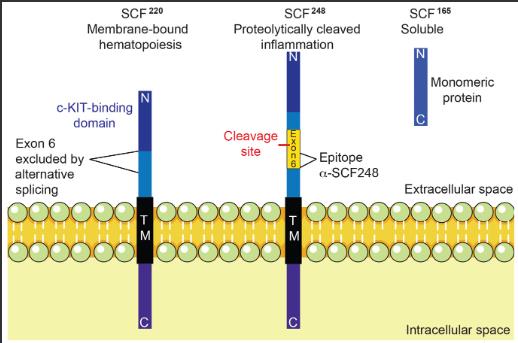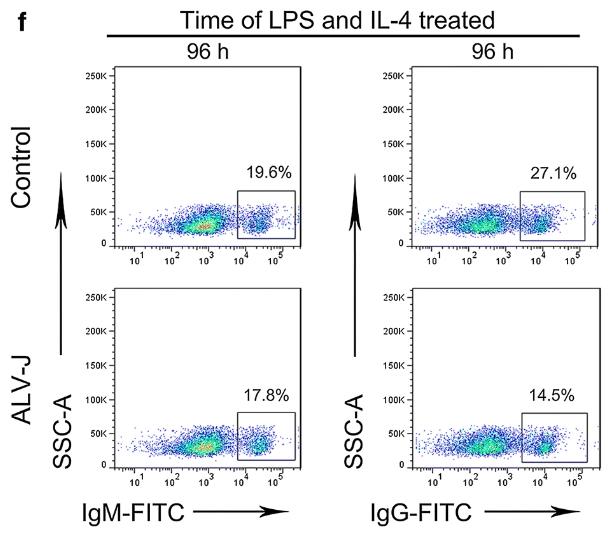Kitlg
-
Official Full Name
KIT ligand -
Overview
This gene encodes the ligand of the tyrosine-kinase receptor encoded by the KIT locus. This ligand is a pleiotropic factor that acts in utero in germ cell and neural cell development, and hematopoiesis, all believed to reflect a role in cell migration. In adults, it functions pleiotropically, while mostly noted for its continued requirement in hematopoiesis. Two transcript variants encoding different isoforms have been found for this gene. [provided by RefSeq, Jul 2008] Murine SCF or Stem Cell Factor, also known as Kit Ligand, is a 273 amino acid cytokine protein expressed from the Kitl gene located on chromosome 10. After initial synthesis and translocation, the 25 residue signal sequence is cleaved, allowing for the 248 residue SCF to properly fold and mature. If the SCF or Kit Ligand is cleaved again on the C- terminal end at residue 190, then the soluble Kit Ligand is formed. SCF, a non-covalently linked homodimer, is known to stimulate the proliferation of mast cells and is able to augment the proliferation of both myeloid and lymphoid hematopoietic progenitors in bone marrow culture. Also, SCF serves to mediate cell-cell adhesion and acts synergistically with other cytokines and interleukins. -
Synonyms
KITLG;KIT ligand;SF;MGF;SCF;FPH2;KL-1;Kitl;SHEP7;c-Kit ligand;steel factor;stem cell factor;mast cell growth factor;familial progressive hyperpigmentation 2;Clo;Con;Gb;SLF;Sl;contrasted;cloud gray;grizzle-belly;hematopoietic growth factor KL;stem cell factor Location: 10 51.4 cM
Recombinant Proteins
- Chicken
- Human
- Mouse
- Bovine
- Swine
- Rabbit
- Feline
- Canine
- Equine
- Rat
- Pig
- Dog
- Mus musculus
- Felis catus
- Sheep
- E.coli
- Insect Cells
- Yeast
- P.pastoris
- CHO
- Barley Grain
- Human Cell
- HEK293
- Hordeum Vulgare
- Mammalian Cell
- Drosophila S2 Cell
- HEK293F
- Mouse
- Insect Cell
- P. pastoris
- Mammalian cells
- N/A
- E.coli expression system
- Non
- His
- Fc
- StrepII
- His&Fc&Avi
- GST
- His&Avi
- Fc&Myc
Background

Fig1. SCF isoforms and α-SCF248. (Wendy Fonseca, 2019)
What is KITLG protein?
KITLG gene (KIT ligand) is a protein coding gene which situated on the long arm of chromosome 12 at locus 12q21. KITLG protein, also known as stem cell factor (SCF), is a growth factor that acts as a ligand for the receptor-type protein-tyrosine kinase KIT. It plays a crucial role in cell survival, proliferation, hematopoiesis, stem cell maintenance, gametogenesis, mast cell development, and melanogenesis. The binding of KITLG to KIT can activate several signaling pathways, including the PI3K/AKT pathway, RAS/RAF/MAP kinases, and STAT family members, which are important for cell adhesion and immune responses. The KITLG protein is consisted of 273 amino acids and KITLG molecular weight is approximately 30.9 kDa.
What is the function of KITLG protein?
KITLG protein, also known as stem cell factor (SCF) or steel factor, is a cytokine that plays a crucial role in cell survival, proliferation, and differentiation. It is involved in embryonic development, particularly in germ cell and neural cell maturation, as well as in hematopoiesis, which reflects its role in facilitating cell migration. KITLG is the ligand for the receptor tyrosine-kinase KIT and acts by binding to this receptor, activating several signaling pathways such as PI3K-AKT, RAS-MAPK, and JAK-STAT. These pathways are important for processes like cell adhesion, hematopoiesis, and gametogenesis. Additionally, KITLG has been implicated in the regulation of energy expenditure and mitochondrial function, with potential implications for metabolic health. Abnormal expression of KITLG has been associated with various types of cancer, suggesting its role as a therapeutic target.
KITLG related signaling pathway
KITLG (KIT Ligand) is a growth factor that plays a pivotal role in cell proliferation, differentiation, and survival, particularly in hematopoietic cells. It binds to the KIT receptor tyrosine kinase, leading to receptor dimerization and autophosphorylation. This activation triggers downstream signaling pathways, including the PI3K/AKT and MAPK/ERK pathways, which are crucial for promoting cell survival, growth, and differentiation. Additionally, KITLG can activate the JAK/STAT pathway, enhancing gene transcription involved in immune responses and hematopoiesis. Dysregulation of KITLG signaling has been implicated in various malignancies, particularly in mast cell leukemias and certain types of lymphomas, highlighting its importance as a therapeutic target.
KITLG related diseases
KITLG is a growth factor critical for the development and differentiation of hematopoietic cells, mast cells, melanocytes, and gametes. Dysregulation or mutations in KITLG or its receptor, KIT, can lead to various diseases. For instance, gain-of-function mutations in KIT are associated with certain types of leukemias, such as systemic mastocytosis and acute myeloid leukemia (AML). Additionally, germline mutations in KITLG can cause Noonan syndrome-like disorder with multiple lentigines (NSML), characterized by developmental abnormalities and skin hyperpigmentation. Furthermore, KITLG overexpression has been implicated in promoting angiogenesis and tumor progression in solid tumors like gastrointestinal stromal tumors (GISTs) and melanomas, making it a potential therapeutic target in oncology.
Bioapplications of KITLG
In triple-negative breast cancer (TNBC), KITLG expression is consistently low and associated with reduced survival rates, suggesting it may function as a suppressor of oncogene activity in this context. Overexpression of KITLG has been shown to increase apoptosis in TNBC cells, potentially by modulating the BCL-2/BAX and Casp3/9 pathways and inhibiting the AKT/PI3K pathway. This implies that KITLG could not only serve as a prognostic marker for TNBC but also as a target for therapeutic intervention, offering a new avenue for treatment strategies in this aggressive form of breast cancer.
Case Study
Case Study 1: Shuhai He, 2019
This study explored the effects of avian leukosis virus subgroup J (ALV-J) on B cell development and immunity. In congenitally infected chickens, researchers observed severe immunological tolerance, poor development of immune organs, and reduced levels of IgM- and IgG-positive cells and total immunoglobulins. B cell development was arrested early, and ALV-J blocked the differentiation of B cell progenitors in the bursa of Fabricius. Humoral immunity was suppressed, as seen in decreased antibody responses to vaccines and reduced B cell proliferation in spleen germinal centers. In vitro, B cell progenitors showed impaired proliferation and differentiation in response to LPS and IL-4. To detect the Ig gene class-switch of the B cell progenitor response to mitogen in vitro, the cells were cultured with chicken SCF.

Fig1. IHC staining for chB6 antigen in tissue sections of spleen using mouse anti-chB6 Ab.

Fig2. Changes in Ig gene CSR (from IgM to IgG) by flow cytometry analysis.
Case Study 2: Jiun-Chi Huang, 2022
Diabetic nephropathy (DN) is a growing health concern, and the effects of hyperglycemia and its byproducts, such as advanced glycation end-products (AGEs), on glomerular endothelial cells (GECs) are not fully understood. These findings show that AGEs boost KIT ligand (KITLG) expression and secretion in GECs, promoting endothelial-to-mesenchymal transition (EndoMT) and enhancing GEC permeability via the AKT/extracellular-signal-regulated kinase pathway. The use of imatinib to counteract KITLG's effects halted AGE-induced EndoMT in GECs, indicating KITLG's significance in GEC damage. Elevated KITLG levels in GECs and urine were observed in db/db mice versus db/m mice, with urinary KITLG correlating positively with the urinary albumin-to-creatinine ratio (ACR). Similarly, type 2 diabetic patients exhibited higher urinary KITLG levels, which correlated with urinary ACR and negatively with the estimated glomerular filtration rate.

Fig3. KITLG protein level in the supernatant of HGECs treated with NG, HG for 48 h. The level of KITLG was determined by an ELISA kit.

Fig4. The correlation between urinary KITLG levels and urinary ACR in human participants.
Quality Guarantee
Involved Pathway
Kitlg involved in several pathways and played different roles in them. We selected most pathways Kitlg participated on our site, such as Ras signaling pathway,Rap signaling pathway,Cytokine-cytokine receptor interaction, which may be useful for your reference. Also, other proteins which involved in the same pathway with Kitlg were listed below. Creative BioMart supplied nearly all the proteins listed, you can search them on our site.
| Pathway Name | Pathway Related Protein |
|---|---|
| Pathways in cancer | WNT2B,AKT1,LAMB2,BIRC5,DAPK3,EP300,MET,CTNNA3,FGF21,TPR |
| Cytokine-cytokine receptor interaction | RNF207B,IFNA3,CCR10,TNFRSF25,IL26,IFNA2,CXCL16,IFNA4,PDGFRB,CXCR6 |
| Hematopoietic cell lineage | CD19,IL4,CD1E,CD59A,CD8B,GP9,CD4,HLA-DRB4,CD8A,HLA-DRB5 |
| Melanogenesis | WNT8A,GNAO1A,FZD5,WNT3,DVL1B,GSK3B,CALM2,CAMK2D1,KITLGB,MITF |
| Phospholipase D signaling pathway | PLA2G4A,KRAS,PIK3CA,HRAS,TSC2,DGKD,PIK3CD,MAPK3,PTGFR,GRM7 |
| Ras signaling pathway | FGF18,GNB4,RASSF5,GAB2,FGF10,VEGFB,GNG10,FLT1,KRAS,MAPK9 |
| PIK-Akt signaling pathway | ITGB3,PDGFA,TCL1A,PPP2CB,INS2,RPS6,INS,FGF3,TCL1B,TNR |
| Rap signaling pathway | SIPA1L2,Itgam&Itgb2,GRIN2B,GRIN2A,PRKCA,PIK3CB,TEK,FGFR2,RASGRP3,ACTG1 |
Protein Function
Kitlg has several biochemical functions, for example, cytokine activity,growth factor activity,protein binding. Some of the functions are cooperated with other proteins, some of the functions could acted by Kitlg itself. We selected most functions Kitlg had, and list some proteins which have the same functions with Kitlg. You can find most of the proteins on our site.
| Function | Related Protein |
|---|---|
| protein binding | LTC4S,VPREB1,GLTP,CIAO1,CFLAR,LPXN,EIF3E,POLR2C,C21orf7,GSTM5 |
| growth factor activity | VEGFAA,GDF10,Kitl,PDGFAB,FGF16,NDP,IGF2,CDNF,NRG2,FGF11A |
| stem cell factor receptor binding | SPRED2,KITLGB,Kitl,KITLGA,SPRED1 |
| cytokine activity | CTF1,TGFB2,LTB,Gm13290,Ccl12,IL11,CD40LG,BMP8B,IL34,INHBA |
Interacting Protein
Kitlg has direct interactions with proteins and molecules. Those interactions were detected by several methods such as yeast two hybrid, co-IP, pull-down and so on. We selected proteins and molecules interacted with Kitlg here. Most of them are supplied by our site. Hope this information will be useful for your research of Kitlg.
KIT;FLT3LG
Resources
Related Services
Related Products
References


.jpg)
.jpg)


